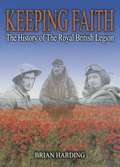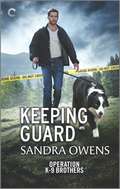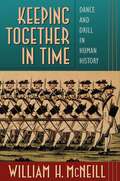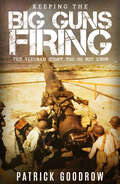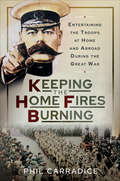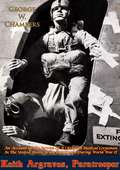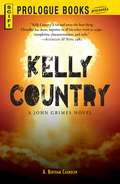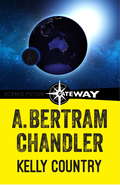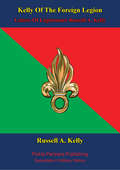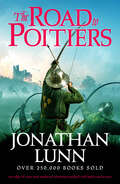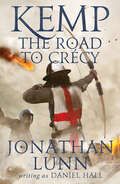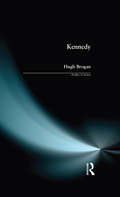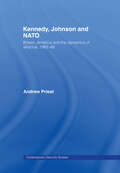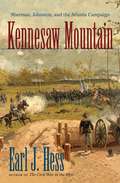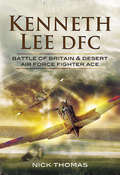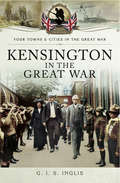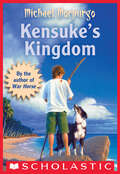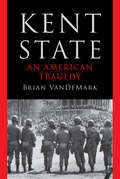- Table View
- List View
Keep the Home Fires Burning: War at Home, 1915 (War at Home #2)
by Cynthia Harrod-EaglesThe year is 1915, and the war is raging on . . . The second book in the War at Home series by Cynthia Harrod-Eagles, author of the much-loved Morland Dynasty novels. Set against the real events of 1915, this is a rich and wonderfully depicted drama featuring the Hunter family and their servants.
Keeping Faith: The History of The Royal British Legion
by Brian HardingFor the millions who had fought in the Great War, and for their families, the 'land fit for heroes' turned out to be an illusion; instead there was suffering and deprivation. Out of this, on 1 July 1921 was born the British Legion. In the years that followed the Legion fought for justice for the ex-service community, meanwhile seeking to protect them. It introduced the Poppy Appeal and insisted on an annual act of national Remembrance for the fallen. It went to extraordinary lengths to try to prevent another war, ultimately finding itself in controversial discussions with Hitler. Even after the Second World War the Legion's work was far from over; the war-disabled and the war widows seemed to have been forgotten in the new welfare state. Remembrance itself appeared to be under threat as the memory of war receded. There were more battles to be fought, while conflicts such as the Gulf War brought fresh problems. Perhaps most inspiring is the human aspect. Those who have done the Legion's work represent every class of society, from admirals and former private soldiers to poppy collectors. But they have one thing in common: compassion for all who have suffered in the service of the country. This is their story too.
Keeping Guard (Operation K-9 Brothers #2)
by Sandra Owens"With realistic characters, witty banter, a well-written storyline, and a bit of action thrown in, Keeping Guard will draw readers in from the first page until the last." —Harlequin JunkieFinding the future they deserve will mean leaving the past behind…Navy SEAL Noah Alba is on extended leave after a terrible mistake resulted in the loss of his K-9 partner. He arrives in Asheville, North Carolina, hoping to get his head on straight before he returns overseas. When an old friend recruits him to train service dogs for veterans, he doesn&’t feel ready. Still, rambunctious rescue dog Lucky is awfully hard to resist—as is the drop-dead stunning bride Noah encounters while hiking.When she finds out her fiancé is only marrying her to gain control of her family&’s brewery, Peyton Sutton&’s I do turns into a hard pass real quick. But Peyton&’s father and now-jilted ex are determined to force the match at any cost. Running away can only get her so far, until Noah—and his adorably fierce canine companion—step in as an unlikely protector.Guarding a runaway bride in the close quarters of her downtown loft is no way to avoid a simmering attraction. But Peyton can&’t outrun her ex, and Noah can&’t outrun his past; they&’ll have to find a way to move forward together, or risk making another terrible mistake.Operation K-9 BrothersBook 1: Operation K-9 BrothersBook 2: Keeping GuardBook 3: Mountain Rescue
Keeping Her Close: A Clean Romance (A Pacific Cove Romance #3)
by Carol RossHired to protect her…unable to resist herThe job sounds simple: teach a businessman’s daughter how to stay safe. But former navy SEAL turned bodyguard Kyle Frasier has a personal motive, too. Harper Jansen is his late best friend’s fiancée. Loyalty demands he protect her, not that Harper looks in need of rescuing. In fact, it’s Kyle who needs help—balancing duty with his desire to build a life with the one woman he shouldn’t want…
Keeping Secrets: A Novel
by Bina BernardFor fans of All the Light You Cannot See and The German Girl, Keeping Secrets is a remarkable debut, by a veteran American magazine journalist exploring her own family's flight from Poland. Hannah Stone, now a successful New York City journalist, was smuggled out of Poland as a child with her parents after surviving the Holocaust. They remade themselves in America, harboring the deep scars of stories never told. Now in her thirties, Hannah learns a family secret that sends her back to where she came from, on the investigative journey of her life. Replayed in cinematic flashbacks, of the family&’s immigrant experience and war years on the run, alternating with the contemporary family drama in the U.S. and Communist Poland, Keeping Secrets hinges on the mystery of a sister who was left behind. In this sweeping, suspenseful debut, Keeping Secrets reveals the agonizing choices World War II thrust upon so many, examining the enormous price of guilt and the very heart of identity.
Keeping Together in Time: Dance and Drill in Human History
by William H. McNeillCould something as simple and seemingly natural as falling into step have marked us for evolutionary success? In Keeping Together in Time one of the most widely read and respected historians in America pursues the possibility that coordinated rhythmic movement--and the shared feelings it evokes--has been a powerful force in holding human groups together. As he has done for historical phenomena as diverse as warfare, plague, and the pursuit of power, William H. McNeill brings a dazzling breadth and depth of knowledge to his study of dance and drill in human history. From the records of distant and ancient peoples to the latest findings of the life sciences, he discovers evidence that rhythmic movement has played a profound role in creating and sustaining human communities. The behavior of chimpanzees, festival village dances, the close-order drill of early modern Europe, the ecstatic dance-trances of shamans and dervishes, the goose-stepping Nazi formations, the morning exercises of factory workers in Japan--all these and many more figure in the bold picture McNeill draws. A sense of community is the key, and shared movement, whether dance or military drill, is its mainspring. McNeill focuses on the visceral and emotional sensations such movement arouses, particularly the euphoric fellow-feeling he calls "muscular bonding." These sensations, he suggests, endow groups with a capacity for cooperation, which in turn improves their chance of survival. A tour de force of imagination and scholarship, Keeping Together in Time reveals the muscular, rhythmic dimension of human solidarity. Its lessons will serve us well as we contemplate the future of the human community and of our various local communities.
Keeping a Warrior (Loving a Warrior #2)
by Melanie HansenSometimes the only hope for the walking wounded is in each other’s arms.Devon Lowe is a survivor.A survivor of war. Of combat. And of a betrayal by men she considered her brothers-in-arms. But her trailblazing work as a Cultural Support Team member working alongside the navy SEALs is too important for her to back down now.Fresh off a painful breakup, air force pararescueman Rhys Halloran recognizes Devon’s trauma for what it is—something that’s left her isolated but far from irreparably damaged.With Devon’s trust still lying shattered back in Afghanistan, putting her faith in a man who’s nursing a broken heart isn’t easy. But she’s tired of people making her feel weak, and Rhys makes her feel anything but, sparking a heated attraction that was never part of the plan.With all eyes on Devon to prove herself in a brutal man’s world, having it all will mean putting her heart on the line like never before. But when it comes to Rhys, it’s an uphill battle she’s ready to fight.Publisher’s Note: Keeping a Warrior deals with topics some readers may find difficult, including past sexual assault.This book is approximately 92,000 wordsOne-click with confidence. This title is part of the Carina Press Romance Promise: all the romance you’re looking for with an HEA/HFN. It’s a promise!
Keeping the Big Guns Firing: The Vietnam Story You Do Not Know
by Patrick GoodrowI would highly recommend this book to anyone who has either served or wondered what it was like to serve overseas during a controversial military action. - Cheryl Thompson, Dog-Eared Reviews Keeping the Big Guns Firing by Patrick Goodrow details some of the experiences of the behind-the-lines troopers who provided the Grunt with much needed support. - Ann Neville for Readers' FavoriteThis is a well written story of one man’s experience with the U.S. Marine Corps during two tours in Vietnam during the latter part of the 1960’s. The man is a staff sergeant with an Ordinance Maintenance Company charged with keeping the artillery – the big guns, firing. Not an easy thing to do, nor a safe one. The enemy was always quick to dispatch a Marine at his work; a heavy weapon quick to dispatch an unfamiliar technician, and an occasional officer quick to dispatch a subordinate’s career to better his own. This is an honest book about men at war doing an unglamorous but dangerous job during a war without clear definition.
Keeping the Home Fires Burning: Entertaining the Troops at Home and Abroad During the Great War
by Phil CarradiceKeeping the Home Fires Burning tells the story of how the troops and the general public were kept happy and content during the First World War. Between 1914 and 1918 there was entertainment of the masses for the sole purpose of promotion of the war effort. It was the first time that a concerted effort to raise and sustain morale was ever made by any British government and was a combination of government sponsored ideas and lucky happenstance. It was all picked up and used by the new Propaganda Ministry. The range of activities was wide and varied, from poetry to cinema, from music hall singers and artists to the creation of battlefield heroes. There was postcard humour and deliberate veneration of philanthropists - and war participants - like Woodbine Willie. The theme of Keeping the Home Fires Burning is backed up by 40 illustrations from the time, including participants, posters, battlefield views and so on.
Keith Argraves, Paratrooper: An Account Of The Service Of A Christian Medical Corpsman In The United States Army Paratroops During World War II
by George W. ChambersThe fascinating true story of Keith Argraves, a man of faith, who served as a medic and paratrooper during World War II.Keith Argraves served in the 506th Parachute Infantry Regiment, he enlisted in 1941 and through much effort finally succeeded in being accepted into the all-volunteer elite paratroopers as a medic. Steeled with faith in God he refused to carry a gun into action. His first taste of action was in North Africa flying into Oran and tending the wounded at the fighting around Taffarui airport. He was later captured by German soldiers of the Afrika Korps after volunteering to go on a "suicide mission" to demolish enemy assets. His adventures in the prisoner of war camps have become legend and read life fiction, but they are indeed fact.
Kelly Country
by A. Bertram ChandlerAn If-Of-History Novel The United States won its independence in 1776, and the world has never been the same since. What if Australia had followed suit? How would our world have been different? That's the theme that fascinated A. Bertram Chandler who saw, in the famous Ned Kelly, the possibility of an Australian Washington. For Ned Kelly was not just a lawless bushranger. He was a man of unusual imagination who created his own armor, gathered a band of Irish rebels, and took arms against the frontier law of old Australia. Now, by time machine and calculated interference, a certain 20th Century John Grimes goes back and alters history. Kelly survives! Utilizing the hidden discoveries of science, Kelly helps an Austrailian-Irish Republic rise from Down Under!
Kelly Country
by A. Bertram ChandlerThere was a Ned Kelly. He lived and breathed and fought for what he believed to be right - according to the historians. According to others he was no more than a bushranger, a vicious criminal who paid the just penalty for his crimes on the gallows. But what if he had lived. What would have been the consequences for Australia - and the world?
Kelly Country
by A. Bertram ChandlerThere was a Ned Kelly. He lived and breathed and fought for what he believed to be right - according to the historians. According to others he was no more than a bushranger, a vicious criminal who paid the just penalty for his crimes on the gallows. But what if he had lived. What would have been the consequences for Australia - and the world?
Kelly Country: A John Grimes Novel
by A. Bertram ChandlerAn If-Of-History NovelThe United States won its independence in 1776, and the world has never been the same since. What if Australia had followed suit? How would our world have been different? That’s the theme that fascinated A. Bertram Chandler who saw, in the famous Ned Kelly, the possibility of an Australian Washington.For Ned Kelly was not just a lawless bushranger. He was a man of unusual imagination who created his own armor, gathered a band of Irish rebels, and took arms against the frontier law of old Australia. Now, by time machine and calculated interference, a certain 20th Century John Grimes goes back and alters history. Kelly survives!Utilizing the hidden discoveries of science, Kelly helps an Austrailian-Irish Republic rise from Down Under!
Kelly Of The Foreign Legion - Letters Of Légionnaire Russell A. Kelly
by Légionnaire Russell A. KellyThe French Army have had numerous foreign regiments in its service for centuries; however, few have the mystique and elite status of the French Foreign Legion. It became a haven for the rough, tough, and adventure-seeking crowds of all of Europe. Bred with a fierce and disciplined esprit de corps, these soldiers could expect to fight France's enemies even in the most desperate of circumstances.Like his American compatriot Henry Weston Farnsworth, Russell Kelly enlisted in the French Foreign Legion as soon as possible after the declaration of war was made and the start of the awful slaughter of the First World War began. After a scant two months of training, Kelly recounts that he and his fellow soldiers were shipped off to the Front. Within a mere three months, his letters tell of the vicious and confused fighting that he was involved in around Bouzy and then in the Arras sector. He and his unit were heavily engaged during the battle of Artois and after a short spell of rest and recruitment were back in the frontlines near Souchez, where Legionnaire Kelly met his end.These letters were thought of such quality and interest that they were published in the New York Evening Sun.
Kemp: An edge-of-your-seat medieval adventure packed with battle and action (Arrows of Albion)
by Jonathan LunnTwo kingdoms clash in one of the greatest battles of the Hundred Years War. September 1356. Martin Kemp and his troop of archers ride with the Black Prince’s army as it burns and plunders its way across France. When they find all the bridges across the Loire are destroyed, however, their hopes of uniting with the Duke of Lancaster’s army are dashed, and a hasty retreat is the order of the day. But a French army is closing in fast and Kemp’s old foe, Sir Geoffroi de Chargny, rides with it, now honoured with the duty of bearing the Oriflamme: the sacred war banner of France. Cut off, outnumbered and running out of supplies, the weary English realise their only hope is to risk everything on a pitched battle, and hope the tricks they used ten years earlier at Crécy will pay off a second time, in a field just a few miles outside of Poitiers… A climactic moment in history expertly told by a master of the genre, perfect for fans of Christian Cameron and David Gilman.
Kemp: The Road to Crecy (Arrows of Albion)
by Jonathan LunnAn epic Medieval adventure of the Hundred Years War When Martin Kemp joins the English army in order to avoid the hangman, he may just be delaying the inevitable. While he remains hopeful that at least there’s the chance for some heroics, the reality is very different. Kemp’s war is instead a terrifying odyssey through the panic and confusion of his first battle, the brutal realities of siege warfare, and eventually to the field of Crécy, where he faces the armoured might of the French nobility. But as an elite longbowman, when it comes to winning or losing, he could have a vital – though dangerous – part to play. This stunning adventure brings the medieval world vividly to life, and is ideal for fans of Bernard Cornwell, Matthew Harffy and Giles Kristian.
Ken Follett Omnibus: Eye of the Needle And Whiteout
by Ken FollettEYE OF THE NEEDLE: His weapon is the stiletto, his codename: The Needle. He is Henry Faber, Germany's most feared undercover agent, and a cold and professional killer. His task: to discover the Allies’ plans for D-Day, and get them to Germany at all costs. It's a task he undertakes with customary relish and ruthlessness — until he encounters Storm Island, and a woman called Lucy... WHITEOUT: An injured lab technician, a missing canister. Toni Gallo, the attractive new head of the security team operating at the local pharmaceutical-research company, knows she has problems, but she has no idea of the nightmare to come. As his family converges on a remote farmhouse in Scotland for the Christmas period, Stanley Oxenford is a worried man. Everything is riding on a new drug he’s developed to fight a lethal virus; all have something to gain with the money he’s going to make. Toni Gallo, too, is out to prove herself as a woman up to her job. Then a blizzard whips out of the north, and as the storm worsens, the emotional sparks — jealousies, distrust and sexual attraction — crackle; desperate secrets are revealed; hidden traitors and unexpected heroes emerge.
Kennedy (Profiles In Power)
by Hugh BroganThis invaluable account provides an excellent introduction to the Presidency of John F. Kennedy. To understand Kennedy's aims and achievements in the White House, it looks at Kennedy the man and outlines his background and early career and the influences upon him. Hugh Brogan shows Kennedy as a credible statesman, a man of solid achievement. His record as President was, broadly, impressive and would have been more so had he lived.
Kennedy, Johnson and NATO: Britain, America and the Dynamics of Alliance, 1962-68 (Contemporary Security Studies)
by Andrew PriestKennedy, Johnson and the Defence of NATO is an incisive reassessment of Anglo-American defence relations, which form a crucial part of international security. Andrew Priest closely examines this key relationship by focusing on the so-called Nassau agreement of December 1962. He clearly places Nassau in its context and shows how multi-level collaboration continued between the US and UK in NATO despite growing tensions over American involvement in Southeast Asia and Britain’s global role. Firstly, he shows how agreements made between Presidents and Prime Ministers shape alliances in by encouraging interaction between politicians, government officials and military personnel at various levels of formality. Secondly, by focusing on the NATO area, he assesses US-UK attitudes to European and North Atlantic defence. Traditionally, studies of US-UK relations at this time have tended to concentrate on developing difficulties between Presidents and Prime Ministers (particularly Harold Wilson and Lyndon B. Johnson), over global issues. This study demonstrates the ‘dynamics of alliance’ through a nuanced approach at high-political, official and ‘working’ levels, across different administrations in the US and UK. Although more recently some authors have successfully integrated such a ‘multi-layered’ approach particularly to studies of nuclear affairs, they have tended to treat the 1962 Nassau agreement as something of a dénouement. This book will be essential reading for students of US foreign policy, British foreign policy, Anglo-American relations, European-American relations and the history of NATO.
Kennesaw Mountain
by Earl J. HessWhile fighting his way toward Atlanta, William T. Sherman encountered his biggest roadblock at Kennesaw Mountain, where Joseph E. Johnston's Army of Tennessee held a heavily fortified position. The opposing armies confronted each other from June 19 to July 3, 1864, and Sherman initially tried to outflank the Confederates. His men endured heavy rains, artillery duels, sniping, and a fierce battle at Kolb's Farm before Sherman decided to directly attack Johnston's position on June 27. Kennesaw Mountain tells the story of an important phase of the Atlanta campaign. Historian Earl J. Hess explains how this battle, with its combination of maneuver and combat, severely tried the patience and endurance of the common soldier and why Johnston's strategy might have been the Confederates' best chance to halt the Federal drive toward Atlanta. He gives special attention to the engagement at Kolb's Farm on June 22 and Sherman's assault on June 27. A final section explores the Confederate earthworks preserved within the Kennesaw Mountain National Battlefield Park.
Kenneth Lee DFC: Battle of Britain & Desert Air Force Fighter Ace
by Nick ThomasThe heroic life of the pilot who became an ace with one of the most successful fighter squadrons in the RAF and a captive in a notorious Nazi POW camp. Following training, Lee received his commission and was posted to 501 Squadron which was sent to support the Expeditionary Force in France, arriving on 10 May, only hours after the Blitzkrieg had been launched. Lee quickly opened his score, claiming several bombers during the first week of operations. Having been wounded when his Hurricane exploded following a dogfight, Lee was briefly rested but soon rejoined the Squadron before they moved to their first Battle of Britain base at Middle Wallop. Lee scored more damaged and destroyed enemy aircraft and by the end of July he was Mentioned in Dispatches. Lee was forced to take to his parachute for the second time, learning of the richly deserved award of his DFC while still recovering from his wounds. He later recalled how each of the Squadrons aces, even Ginger Lacey, had been shot down at least twice during that summer. Lee was later posted to 112 (Shark) Squadron, flying Curtis Kittyhawks on Fighter and Fighter-Bomber missions in North Africa and then to 260 Squadron which was heavily involved in the lead-up to the battle of El Alamein, seeking out and destroying enemy troop columns and fighting off the Luftwaffe which still had air superiority. In March 1943, 123 Squadron began Fighter-Bomber operations against Mediterranean targets. During one Lee was hit by AA and made a forced landing in an olive grove. He was captured and sent to Stalag Luft III just in time to play a key role in the Great Escape.
Kensington in the Great War (Your Towns & Cities in the Great War)
by G. I. InglisHow the experience of war impacted on the town, from the initial enthusiasm for sorting out the German kaiser in time for Christmas 1914, to the gradual realization of the enormity of human sacrifice the families of Kensington were committed to as the war stretched out over the next four years. A record of the growing disillusion of the people, their tragedies and hardships and a determination to see it through. The Royal Borough of Kensington was an area of huge contrasts: vast riches in the south, but marked poverty in the north. It was close enough to the heart of London that national and London-wide affairs often impinged on local life, while local residents might have national reputations. Thus enormous crowds attended the interment at Brompton Cemetery of one of Britain's finest air heroes, Sub-Lieutenant Warneford, striking London policemen left an indelible impression as they marched their way through the Borough, while Kensington resident Mrs Dorothy Peel attempted to teach the nation how to make food economies in answer to the submarine threat, but there are also quirky magistrates, stroppy butchers, Mr Bushman the ultra-patriotic cartoon character, dangerous dog-walkers who would sweep your feet from under you in the dark nights and some vivid first-hand accounts such as watching the first Zeppelin come down. The man who turned Kensington into a Borough at war was undoubtedly William Davison (later Sir William) - Kensington's Mayor throughout the war years. He helped complete the local territorial battalion (the 13th Kensingtons), threw his weight behind recruiting a second battalion, and finally raised a Kitchener battalion from scratch, the 22nd Royal Fusiliers, with all their clothing and accoutrements, and even a fully-fitted hutted camp. He was obliged to display enormous organising energy in the in early years and thereafter seemed to be involved in almost everything, from getting food parcels to POWs to serving on Tribunals.We are fortunate that the Mayor left behind 7 volumes of wartime cuttings, while the local Kensington News was an outstanding source
Kensuke's Kingdom (Ks3 Guided Reading Ser.)
by Michael MorpurgoA young boy is stranded on a small island with a mysterious man who shows him how to survive in this adventure story by the acclaimed author of War Horse. When Michael&’s father loses his job, he buys a boat and convinces Michael and his mother to sail around the world. It&’s an ideal trip—even Michael&’s sheepdog can come along. It starts out as the perfect family adventure—until Michael is swept overboard. He&’s washed up on an island, where he struggles to survive. Then he discovers that he&’s not alone. His fellow-castaway, Kensuke, is wary of him. But when Michael&’s life is threatened, Kensuke slowly lets the boy into his world. The two develop a close understanding in this remote place, but the question of rescue continues to divide them. Praise for Kensuke&’s Kingdom&“[A] poignant adventure story . . . This well-crafted story has all the thrills and intrigues of Gary Paulsen&’s Hatchet . . . and Theodore Taylor&’s The Cay . . . and it will resonate with the same audience.&” —School Library Journal&“Highly readable.&” —Booklist
Kent State: An American Tragedy
by Brian VanDeMarkA definitive history of the fatal clash between Vietnam War protestors and the National Guard, illuminating its causes and lasting consequences. On May 4, 1970, at Kent State University in Ohio, political fires that had been burning across America during the 1960s exploded. Antiwar protesters wearing bell-bottom jeans and long hair hurled taunts and rocks at another group of young Americans—National Guardsmen sporting gas masks and rifles. At half past noon, violence unfolded with chaotic speed, as guardsmen—many of whom had joined the Guard to escape the draft—opened fire on the students. Two reductive narratives ensued: one, that lethal state violence targeted Americans who spoke their minds; the other, that law enforcement gave troublemakers the comeuppance they deserved. For over fifty years, little middle ground has been found due to incomplete and sometimes contradictory evidence. Kent State meticulously re-creates the divided cultural landscape of America during the Vietnam War and heightened popular anxieties around the country. On college campuses, teach-ins, sit-down strikes, and demonstrations exposed the growing rift between the left and the right. Many students opposed the war as unnecessary and unjust and were uneasy over poor and working-class kids drafted and sent to Vietnam in their place. Some developed a hatred for the military, the police, and everything associated with authority, while others resolved to uphold law and order at any cost. Focusing on the thirteen victims of the Kent State shooting and a painstaking reconstruction of the days surrounding it, historian Brian VanDeMark draws on crucial new research and interviews—including, for the first time, the perspective of guardsmen who were there. The result is a complete reckoning with the tragedy that marked the end of the sixties.

